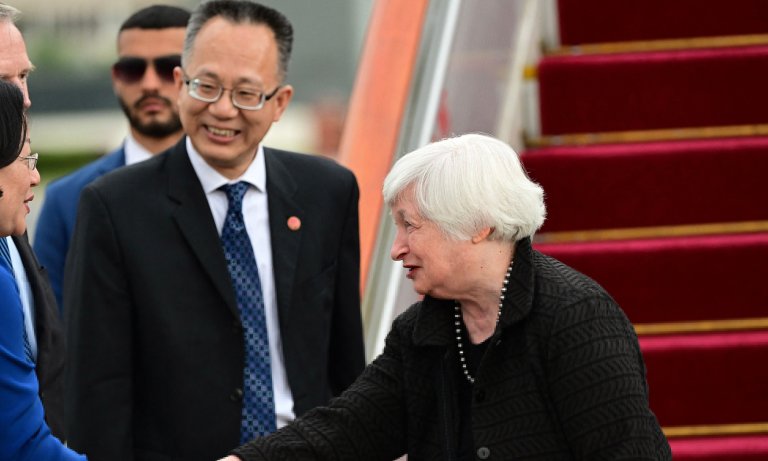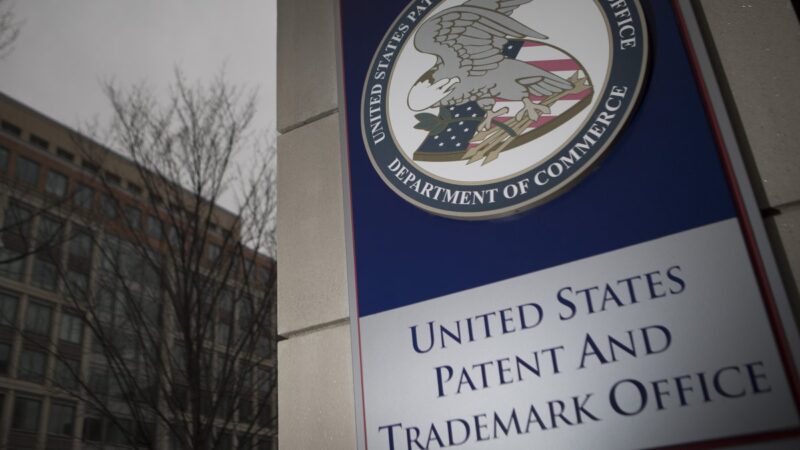Beyond Decoupling: Managing the U.S.-China Innovation Relationship

By Christopher Borges
America’s innovation partnership with the People’s Republic of China is seeking a new equilibrium, recognizing China as the most important strategic competitor on one hand, and acknowledging the realities of mutual dependencies and economic pragmatism on the other. Treasury Secretary Janet Yellen’s visit to China has to balance both these realities.
China has emerged as the second largest economy and military spender in the world behind the U.S., prompting some experts to frame the ongoing innovation competition between the two nations as a “Tech Cold War.” Unlike the Cold War between the United States and the Soviet Union, however, the Chinese and American economies are deeply integrated. Each nation relies on the other for a significant portion of its global trade.
Given their economic integration yet profound ideological differences, some experts call for the United States to engage in technological “decoupling”—a reduction in dependency on Chinese industry for critical technologies. National security officials assert that dependence on China for critical technologies and raw materials is a grave security risk, as it may allow China to weaponize its control of these resources to pursue its strategic objectives. China has done this in the past, for example, by imposing a near complete ban on Lithuanian exports after Lithuania increased diplomatic relations with Taiwan. More recently, China has banned the export of gallium and germanium-related items—two metals required for manufacturing semiconductors, mostly used in electric vehicles, displays, and defense equipment—in response to U.S. actions to ban the export of leading-edge semiconductor equipment to China.
Critics of decoupling assert that it will undermine U.S. innovation and potentially increase the odds of armed conflict if done indiscriminately. Speaking recently at a House Financial Services Committee hearing Secretary Yellen said “I think we gain and China gains from trade and investment that is as open as possible, and it would be disastrous for us to attempt to decouple from China”.
While there is truth to these arguments, the impetus to decouple is not a unilateral U.S. decision. Indeed, it is being actively driven by Chinese actions that appear to conform to that nation’s long-term strategic planning. China has striven for decades to limit its dependence on foreign firms while increasing its influence over globally critical technologies and their supply chains. When considering the risks of decoupling, it is imperative to recognize China’s actions and objectives.
The “Great Firewall” of China
The idea of decoupling may be relatively new from a U.S. perspective, but China has long understood the value of maintaining distinct technology industries to preserve its freedom to pursue key state objectives. Since the 1990s, for example, China has actively prevented the integration of its domestic internet with the global internet for this reason.
The Chinese effort to maintain a domestic internet separated from the Western internet is colloquially known as the “Great Firewall,” which remains in place today. The Great Firewall serves primarily to control access to information in China, which it does quite effectively. China employs teams of censors to monitor online communications, news, and social media and remove information deemed detrimental to state security, creating one of the most restrictive media environments in the world. Further, the Great Firewall has facilitated the development of Chinese internet companies. Instead of relying on U.S. tech giants such as Google and Meta, Chinese national champions such as Baidu, Alibaba, and Tencent dominate the Chinese internet.
Technology Transfer and IP Theft
In industries where there is integration with foreign economies, China pursues its goal of reducing dependency on foreign firms through both forced technology transfer and intellectual property (IP) theft. China is an attractive consumer market for technology companies due to its massive middle class and strong technology manufacturing base. China leverages these strengths to pressure, or even require, foreign firms to transfer technology and tacit knowledge to their Chinese partners. For example, a foreign aviation company seeking to establish manufacturing operations in China must, by law, enter a joint venture with a Chinese partner, which often requires transferring technology as part of the deal.
When technology transfer is not sufficient, China engages in IP theft to steal foreign technologies which are then utilized to develop China’s domestic industry. In 2020, FBI director Christopher Wray described Chinese economic espionage as “the greatest long-term threat to our nation’s information and intellectual property,” and therefore to its economic and national security. However, Chinese cyber espionage began long before then—operations to steal IP from American technology companies were identified as early as 2010. Chinese IP theft is pursued at scale and remains a grave threat to this day, with the FBI estimating that IP theft costs the U.S. economy between $225 billion and $600 billion annually.
Made in China 2025
As China’s economic development has progressed, its goal of technological self-sufficiency has become more explicit. Today, China acknowledges that it is focused on controlling critical technologies, which is stated in a key Chinese industrial policy initiative called Made in China 2025 [SS1] (MIC 2025).
MIC 2025 is a broad set of policies designed to boost Chinese competitiveness in various key technological industries, such as semiconductors, clean energy, and aerospace. The diverse set of policies employed to meet the objectives of MIC 2025 includes direct state subsidies, mobilization of state-owned enterprises (SOEs), and acquisitions of foreign companies to facilitate technology transfer. Furthermore, MIC 2025 calls for China to lead in each part of the value chain for these critical technologies, thereby reducing dependence on foreign nations.
The sheer amount of Chinese state investment in science and technology is staggering. Conservative estimates place Chinese spending in 2019 at $248 billion, or 1.73 percent of GDP. This is double the amount of investment as the second largest spender by GDP percentage and over twice as much as the United States invests by total dollar amount.
In March 2023, the National People’s Congress also passed a State Council restructuring plan to transfer some functions of the Ministry of Science and Technology of China (MOST) to other departments and establish a new Central Science and Technology Commission to accelerate China’s progress towards its science and technology goals. Experts believe that the reorganization will streamline MOST’s ability to allocate resources for science and technology innovation while enhancing the leadership of the Chinese Communist Party.
Industrial Policy in Action: Electric Vehicles
The electric vehicle (EV) industry is a prime example of the impact that Chinese state investment can have on the industries it is targeting for control. Chinese policymakers strove for decades to develop a world-leading EV industry and succeeded: China is now the world’s largest EV maker, outselling U.S. EV manufacturers by six million vehicles in 2022. State support does little to sustain the industry today—government subsidies expired at the end of 2022—but long-term state planning and support was vital to the development of the thriving Chinese EV industry.
China spent decades supplying automakers and consumers with subsidies and tax-incentives while investing in the infrastructure necessary to lay the foundation for a strong EV industry. As early as 2009, China supplied taxi fleets and local governments with subsidies of up to $8,800 per vehicle to purchase EVs. Incentives like these to purchase EVs were combined with hefty state investments in research and development (R&D). In 2001, China designated EV technology as a priority research field, and by 2015 the Chinese government had invested over $1 billion in EV R&D.
China does not hesitate to support individual companies either. In 2017, the Chinese government granted XPeng, a Chinese EV startup, a $233 million loan to construct its first manufacturing plant. BAIC BluePark, another EV maker, received over $140 million in subsidies in both 2018 and 2019. In pursuit of developing national champions that can compete on the world stage, China is not afraid to spend heavily.
Chinese EV companies have further benefitted from China’s technology transfer requirements and state-led IP-theft campaign. Since 1994, automakers wishing to establish operations in China were forced to enter joint ventures with Chinese companies and to this day face heavy pressure to transfer EV technology to their local partners. The allure of the Chinese auto market and manufacturing capabilities have led major auto manufacturers, such as General Motors, to enter joint ventures and transfer their technology. Incidents of IP theft in the EV industry continue to be revealed as well. In recent years, both Apple and Tesla have accused former employees of providing trade secrets to XPeng. Today, XPeng has a valuation of over $8 billion, sells tens of thousands of EVs in China, and even exports EVs to Europe.
Thanks to these determined efforts, China’s EV industry today is world-class. China boasts over 30 distinct EV makers, which may account for nearly half of all EV makers worldwide. At least 12 of these companies manufactured over 100,000 EVs each in 2022, and Chinese auto-manufacturers in total sold over 750,000 EVs in December 2022 alone. BYD, the largest Chinese EV maker, exports thousands of EVs annually to nations such as the UK, Belgium, Australia, and New Zealand. These EVs are not just competing with Western models on government-subsidized prices either. Auto-dealers in Europe remark that many Chinese EVs possess innovative features which attract buyers.
Wither Decoupling?
The history of the Chinese EV industry highlights the substantial efforts of Chinese industrial policymakers and the risks faced by the United States if it does not invest at scale and with long-term commitment in its own innovation system. China is spending at an unprecedented level on developing its domestic technology industries to reduce its reliance on foreign firms while increasing reliance of these foreign firms on China. It has long engaged in questionable, if not outright illegal, practices to acquire foreign technologies and boost its own domestic industries. As demonstrated by the Great Firewall, China clearly understands how maintaining technology industries separate from the West allows it more freedom of action. Finally, China has proven success in establishing world-leading industries through state-led investment.
The United States faces economic risks, especially in the short term, by decoupling from China in specific industries. However, a more strategic approach to the U.S.-China innovation relationship must consider Chinese intensions and actions as well. The United States needs to follow through on its investments to renew its own innovation system—as expressed in the CHIPS and Science Act, the Inflation Reduction Act, and the Infrastructure Investment and Jobs Act. Ultimately, the choice is not one of “decouple” or “not decouple” but rather of investing in value chains connecting research and productive capacity that are more secure and resilient to China’s aggressive economic and military-strategic goals.
This piece was originally published on July 6th, 2023 with the Renewing American Innovation (RAI) Project at the Center for Strategic and International Studies (CSIS)


Assessing the Patent and Trademark Office’s Inventorship Guidance for AI-Assisted Inventions
